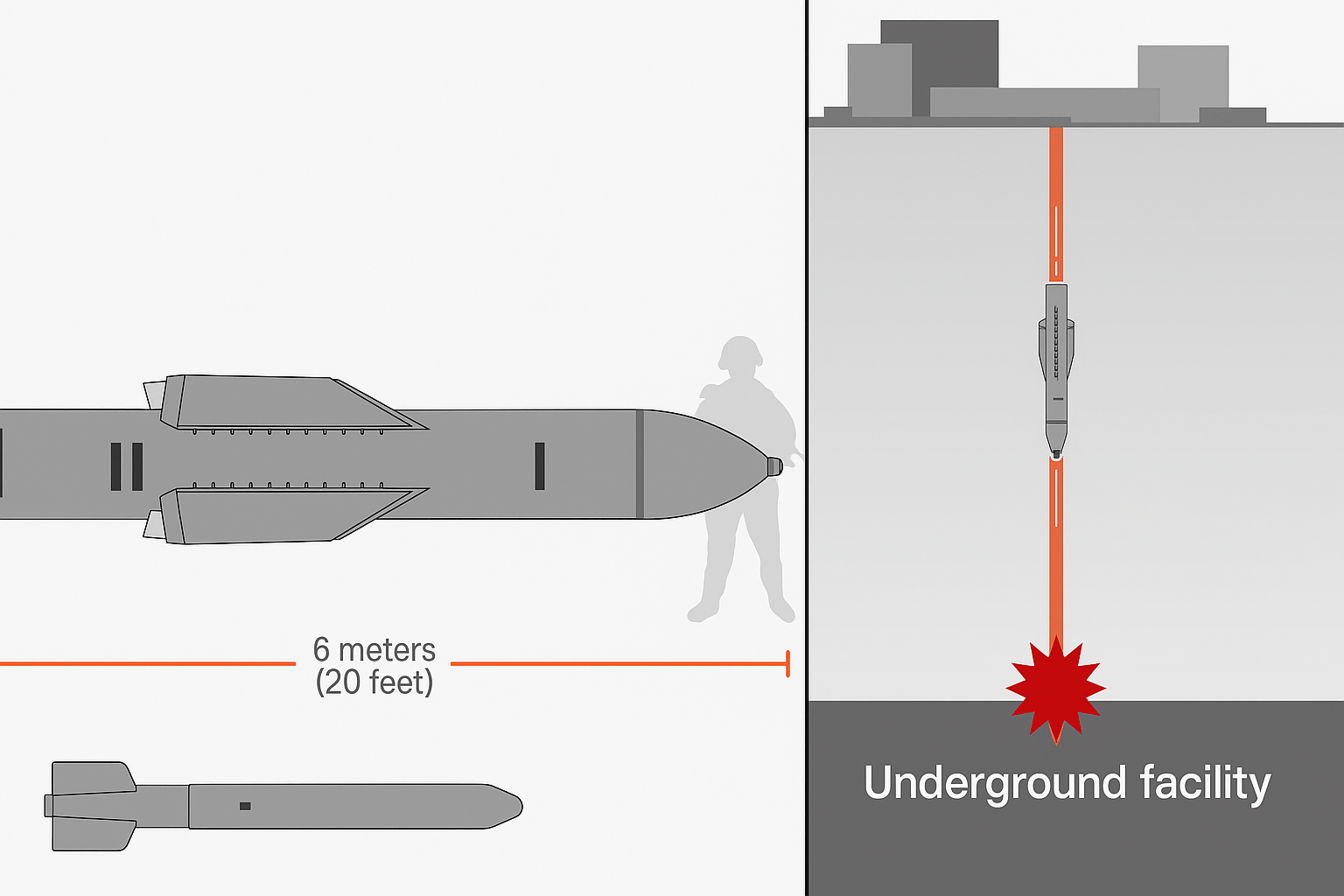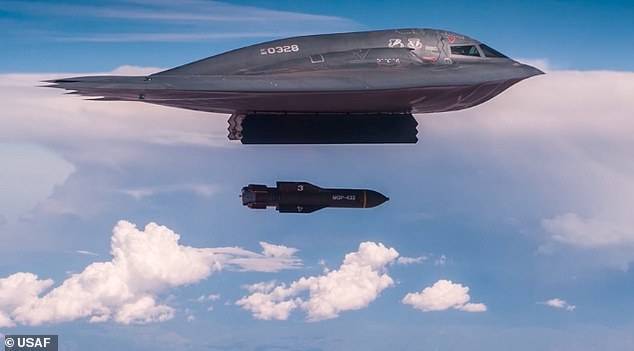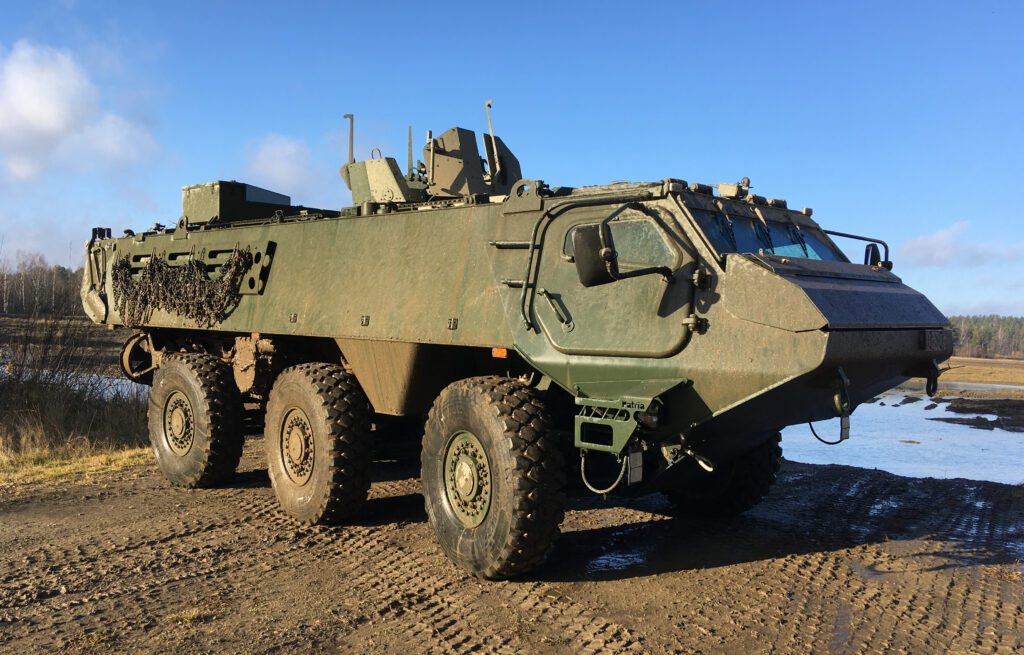The skies over Iran have entered a new era of vulnerability. As Israel’s elite F‑35I “Adir” fighters carved deep into Iranian airspace, the United States launched a simultaneous strike using its GBU‑57 Massive Ordnance Penetrators (MOPs), marking both countries’ most audacious joint operation against Tehran’s nuclear network.
Israeli F‑35s, supported by F‑15s and F‑16s, led “Operation Rising Lion” with over 200 sorties targeting more than 100 sites—air defences, missile silos, nuclear facilities, command centres—from Natanz to Tehran. Their mission: suppress enemy air defences, blind radar networks via electronic‑warfare suites and clear the path for follow‑on strikes. Despite Iranian claims of downing F‑35s, no evidence has emerged. Analysts suggest one plane may have evaded a near‑miss from Tor‑M1 or Khordad batteries—remarkable given the mission depth.
US Brings the Hammer: GBU‑57 MOP
At daybreak on June 22nd, 2025, two US B‑2 stealth bombers dropped a dozen 30‑ton MOPs on Fordow and two on Natanz. The GBU‑57, manufactured by Boeing, is nearly 20 ft long. Costing over $500 m per unit, it is the most powerful conventional bomb in existence. It can punch through roughly 60 m of standard concrete—but Iran’s ultra‑high‑strength concrete may blunt that reach to under 10 m.
Despite its size, the MOP’s GPS/INS guidance and void‑sensing fuse can detonate deep within subterranean caverns—if it hits precisely. Electronic‑warfare support, likely borrowed from Israel’s SPICE‑style systems, appears to have helped defeat any GPS jamming.
How the MOP Works

- Design: Narrow 20.5 ft bomb with thick Eglin‑steel casing; 20% explosive filler (AFX‑757/PBXN‑114), 80% penetrator body.
- Penetration: Up to ~60 m of standard (5,000 psi) reinforced concrete; only ~8 m into ultra‑high‑strength concrete (>10,000 psi), which Iran may possess.
- Fusing: Likely uses void‑sensing delay fuses to detonate within cavities deep underground.
- Guidance: GPS/INS reliant—vulnerable to jamming. Studies in Ukraine showed accuracy fell from ~20 m to ~1,200 m under severe jamming.
- Accuracy Enhancements: There’s speculation US may consider adding a camera/AI seeker (akin to Israel’s SPICE), but retrofitting would take weeks.
Built Around Air Supremacy
Together, Israel and the US have demonstrated a military doctrine built around air supremacy: the ability to launch deep, coordinated strikes against hardened targets with impunity. Israeli F‑35Is pierced Tehran’s defences; American MOPs punched through earth and rock. It’s a demonstration that no bunker is safe—from the skies.
Strategically, it lays bare the gap in Iran’s air‑defence network: advanced systems in place on paper, but overwhelmed and fragmented in execution.
Escalation Pathways: Tehran’s Reckoning
Iran retaliated swiftly, launching ballistic missiles at Israel—small-scale yet symbolic. Tehran has threatened “all options open,” including strikes on US personnel and bases across the Middle East.
Expected Response:
- Proxy warfare via Hezbollah in Lebanon, Houthis in the Red Sea, and ISIS‑style affiliates targeting US installations in Iraq, Syria, Bahrain and Qatar.
- Cyber assaults targeting financial, energy and defence sectors.
- Maritime threat escalation, including mine warfare in the Strait of Hormuz.
- Terrorist attacks against Western interests globally.
Trump, Peace Prizes and Political Fallout
Just a day before the assault, President Trump was in full “peace envoy” mode, urging for a Nobel Peace Prize. Instead, he authorised one of the most aggressive conventional air campaigns in decades.
Domestically, critics argue he bypassed the US Congress and slid from diplomat‑in‑chief to wartime commander overnight. Allies in Europe have urged restraint, warning the strikes jeopardise global security.
Airpower has now become the centrepiece of Western policy on Iran. Israel’s F‑35s shattered the skies; American MOPs shattered the bunkers. The message is unmistakable: no hideaway is safe. But Tehran’s next moves—missile strikes, proxy attacks, cyber blizzards—will determine whether this marks a turning point or the beginning of a broader entanglement.
US Bunker Busters Since 1990s
- GBU‑28 (1991): Laser‑guided, 5,000 lb bomb. Developed during Desert Storm to penetrate 50 m of soil / 5 m of concrete. Created and deployed in two weeks.
- GBU‑37 (1990s): 5,000 lb GPS-guided bunker‑buster, exported to allies including Israel.
- MOP Development: Initiated after the Iraqi deeply‑buried bunkers (2003). First tested in 2007, operational by ~2011. The initial batch was ~20 units.
- GBU‑72 (since 2021): 5 K-lb “advanced” penetrator using improved casing and GPS/INS; deployable from B‑1, F‑15E & F‑15I.
Used In Gaza, Iraq, Syria and Iraq
- Israel: Operates SPICE‑guided satellite/IMU bombs (e.g., GBU‑31/32 with SPICE kits) against hardened targets in Gaza and Iran.
- US in Afghanistan (MOAB, 2017): Though labelled a “bunker‑buster”, the GBU‑43/B (MOAB) uses blast overpressure vs deep penetration. Offers area effect, not subterranean reach.
- US in Iraq and Syria: GBU‑28 and GBU‑37 used vs underground terrorist hideouts and bunkers; none matched the depths targeted in Iran.
Read More:
- The Daily Mail: US Air Force posts highest quality video ever of secret B2 stealth bomber dropping two ‘mother of all bunker buster bombs’ as tensions with Iran increase
- The Sunday Times: How a US strike on Iran could unfold, step by step
- Wikipedia: American strikes on Iranian nuclear sites
- NDTV: B2 Bombers, Bunker Busters, Tomahawks: The Weapons US Used To Strike Iran
- Al Jazeera: US joins Israel in attacking Iran, strikes Fordow, Isfahan, Natanz sites
- NY Post: What are bunker busters: Everything to know about the $500M bombs
- Wikipedia: GBU-72
- Wikipedia: GBU-57A/B MOP
- Business Insider: Israel’s air superiority lets it strike Iran on the cheap — and force Tehran into costly retaliation
- Time: Air Supremacy Over Tehran Gives Israel a Decisive Edge—And Raises New Risks
- Reuters: Israeli air power reigns over Iran, but needs US for deeper impact
- Military Watch Magazine: Iran Claims Shootdown of Fourth Israeli F-35: Stealth Fighter Was Operating Deep Inside Hostile Airspace
- Time: Air Supremacy Over Tehran Gives Israel a Decisive Edge—And Raises New Risks
- Global Times: Iranian media claims two Israeli jets downed, pilot captured; Israel rejects report
- The Times of Israel: Iran claims it shot down Israeli F-35; IDF unaware of any losses
- The Economic Times: F-35 beware! American stealth fighter has been shot down, and an innovative method was used to lock on to the advanced combat jet
- The Times of India: Iranian Military Shoots Down US-Supplied Israeli F-35 Aircraft Over Iran Skies? Big Claim By Tehran (YouTube)
- ISW: Iran Update Special Report, June 16, 2025, Evening Edition
- ISW: Iran Update Special Report, June 21, 2025, Evening Edition
- NPR: Israel claims control of Iran’s skies, but Tehran is managing to hit back
- Le Monde: Israel-Iran conflict: How Israel gained air superiority over Tehran
- WSJ: Israel Takes Control of Iran’s Skies—a Feat That Still Eludes Russia in Ukraine
- MEMO: Israel receives 3 more F-35 fighter jets, boosting fleet to 45
- U.S. Naval Institute: Iran-Israel Conflict: A Quicklook Analysis of Operation Rising Lion
- ABC News: How the 30,000-pound “bunker buster” bomb works (YouTube)



